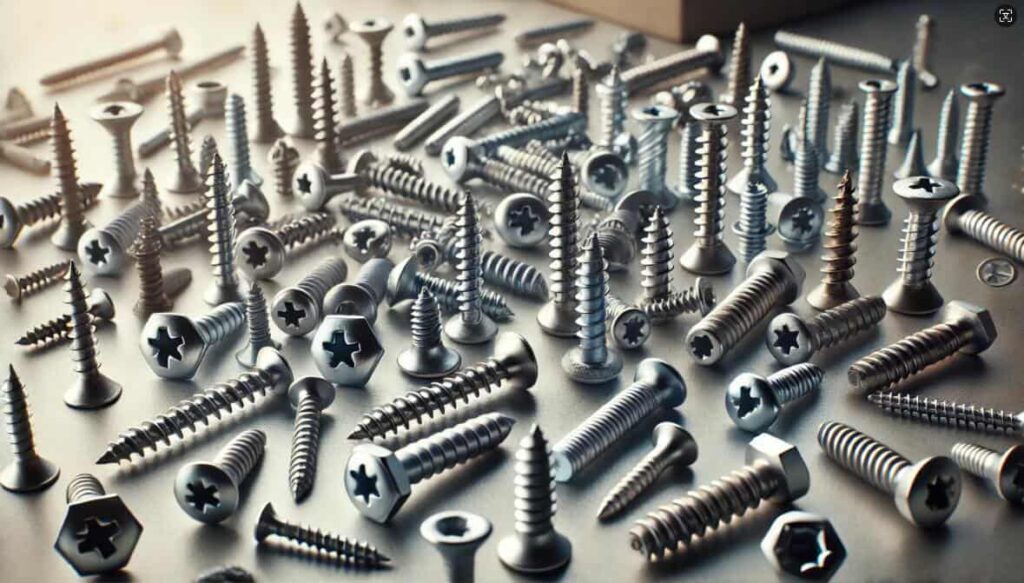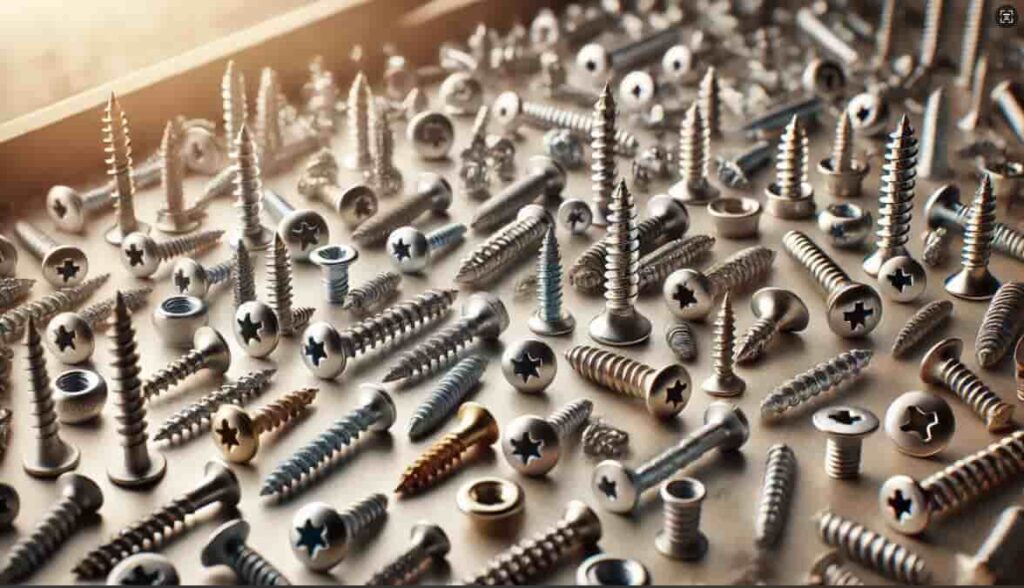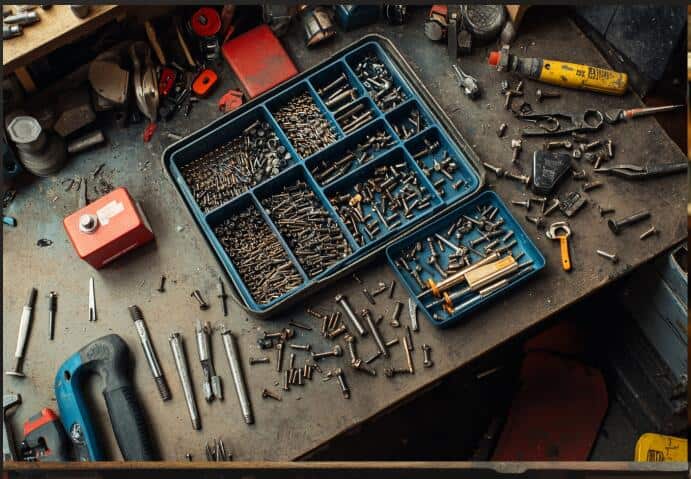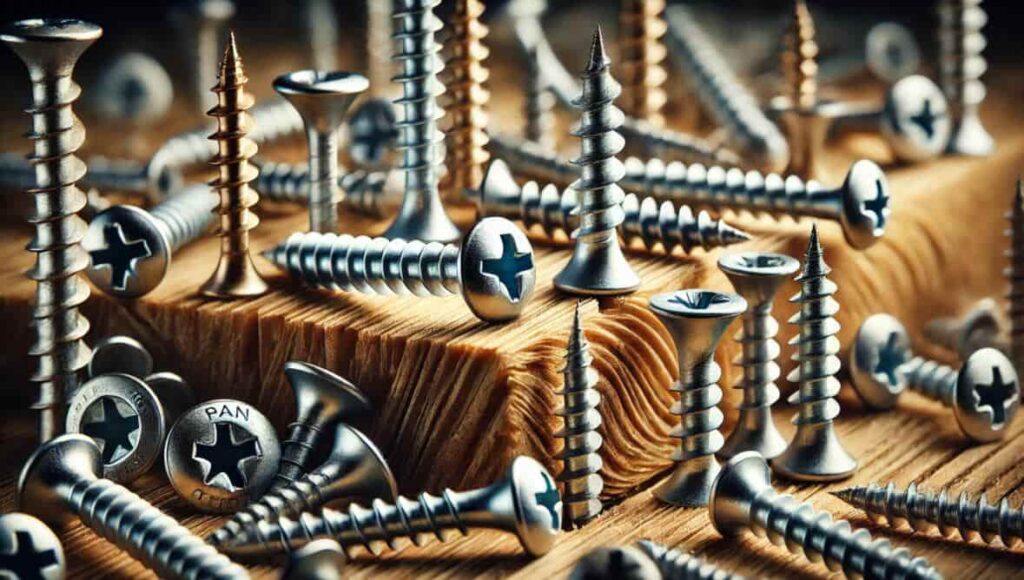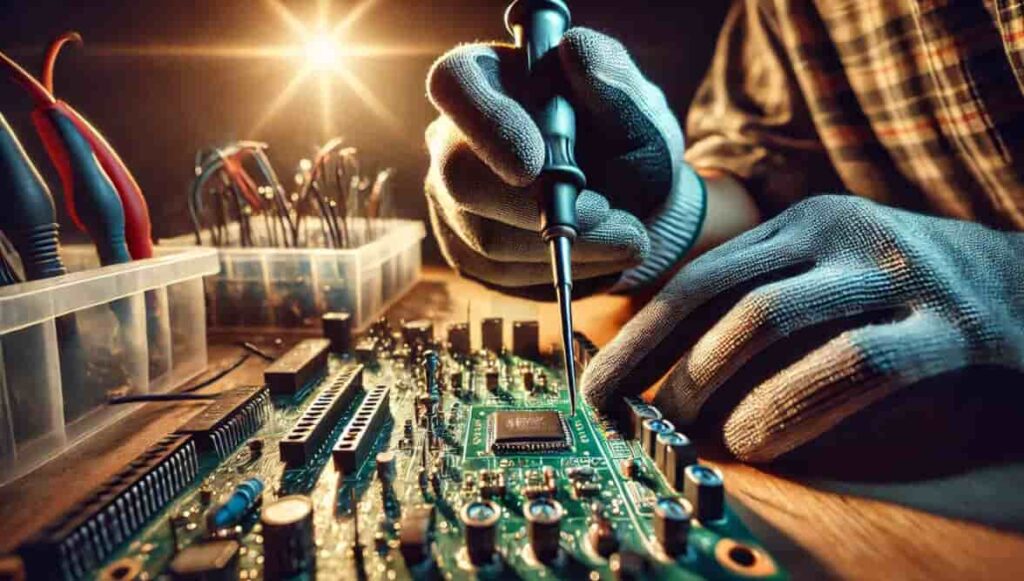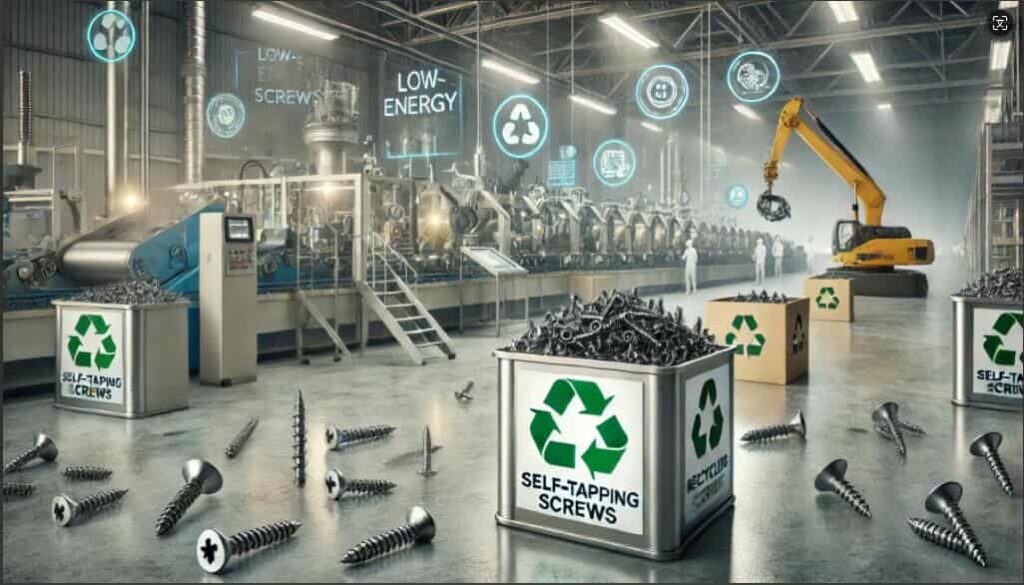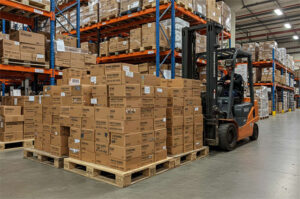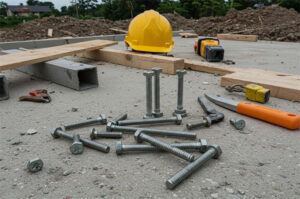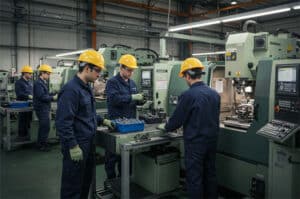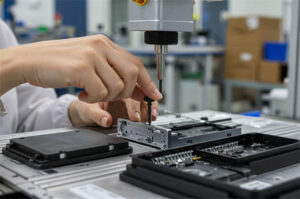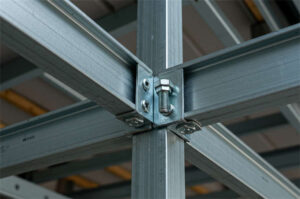Self-tapping screws are suitable for use in non-metallic or soft metals and do not require the use of pre-drilled and tapped holes. The pointed design of self-tapping screws allows them to ‘self-tap’ into the material, whereas ordinary screws are usually flat and of the same size. The key to self-tapping screws is that the holes are drilled without tapping. These screws differ from normal screws in that they have a sharp head and a larger pitch, somewhat similar to chipless tapping. This is typically used in metals and plastics where tapping is not required. In soil materials, the threads of self-tapping screws are able to penetrate, extrude and fit tightly by virtue of their own design.
Introduction to the structural elements of self-tapping screws.
A self-tapping screw consists of three parts: the shank, the end of the shank and the body of the screw. The structure of each self-tapping screw consists of four elements: head shape, rotation, screw type and tail design. There are many types of head shapes, including round head (semi-circular head), flat round head, round head with padded cam, flat head with padded cam, pan head screws with pads, countersunk head, semi-countersunk head, cylindrical head, curved cylindrical head, flared head, hexagon head, hexagon flange head and hexagonal cam with pads.
There are various ways of wrenching and twisting. External wrenches can be hexagonal, hexagonal flange face, hexagonal convex die, hexagonal flower shape, etc.; internal wrenches include a slot, cross-slot H-type (Phillips), cross-slot Z-type (Pozidriv), cross-slot F-type (Frearson), quadrilateral slot (Scrulox), composite slots, internal spline, hexagonal (Plum Blossom grooves), internal triangular, internal hexagonal, internal 12-angled, and clutch grooves, Hexalobular grooves and high-torque cross grooves, among others.
There is a wide variety of screw thread types, including self-tapping threads (wide threads), machine screws, drywall screws, plywood screws, and many other screws. In addition, screws can be divided into single lead (single head), double lead (double head), multiple lead (multiple head), and how many teeth double head threads according to the different leads. There are two main types of tail ways: serrated end and friendly end.
Depending on how it is used, it is possible to machine pipe grooves, grooves, wounds or drill-like shaped sections with perforation functions. A variety of sawn end or flat end methods also exist for different needs. As can be seen from the above, there are many variations of head shapes, twisting methods, screw types and rod end designs for self-tapping screws. They can be combined with each other to form many different types of self-tapping screw products.
What are the main characteristics of self-tapping screws?
Although there are many types of self-tapping screws, they all possess the following key features:
In general, the products are mainly manufactured using carburised steel, which accounts for about 99% of the products. They can also be manufactured using stainless steel or non-ferrous metals.
(2) The goods must be heat-treated. Carbon steel self-tapping screws need to be nitrided, while stainless steel self-tapping screws need to be dry hardened. This ensures that the self-tapping screws meet the standard mechanical properties and performance parameters.
(3)Product surface hardness is high, while the internal has good toughness, forming a ‘soft inside and outside the rigid’ characteristics. This is an important feature of the technical performance of self-tapping screws. If the surface hardness is not enough, it can not be effectively screwed into the substrate; and if the internal toughness is poor, it is difficult to use. Therefore, ‘softness on the inside and rigidity on the outside’ is a key requirement for self-tapping screws to fulfil their performance in use.
Surface maintenance is necessary, usually using electroplating process. Some products require phosphate treatment (phosphating) to solve the problem. For example, wall panel self-tapping screws are prone to phosphating.
(4) Cold heading process is recommended for production. It is recommended to use fast cold head machine, fast grinding machine or fast planetary rolling machine to ensure product quality. This will ensure that the head shape of the self-tapping screws is excellent and the screws are of higher quality.
Self-tapping screws: Exploring their applications and benefits
The main advantage of self-tapping screws is that they do not require prior drilling or tapping. They are available in a wide range of types and sizes to suit different applications and load requirements. It is important to note that self-tapping screws are not suitable for all situations as they have a limited bite in the material, which may cause the screw to loosen or fall out if too much force is applied. Due to their convenience, ease of use and economy, self-tapping screws have become an important part of modern joining technology.
Self-tapping screws are usually manufactured from carbon steel, stainless steel or carbon steel. They have a high degree of hardness and wear resistance and are able to screw directly into softer materials such as wood, plastic and thin copper sheets. This design allows the screws to cut their own holes to fit their own threads for fastening.
The biggest advantage of self-tapping screws is that they do not need to be drilled or tapped in advance. This significantly simplifies the installation process and shortens the labour period, and is particularly suitable for materials where the backside cannot be reached. Self-tapping screws show their convenience, for example, when installing many components of cabinets, furniture or electronic equipment.
Self-tapping screws are available in a variety of types and sizes for different applications and load requirements. For example, some self-tapping screws are designed for wood, while others are suitable for metal materials. They are available in sizes ranging from very small to relatively large diameters and can therefore fulfil diverse joining requirements.
In the electrical field, self-tapping screws are commonly used to securely fasten wires in junction boxes. Self-tapping screws also play an important role in the manufacturing industry, especially when working with lightweight materials or when parts need to be assembled and disassembled quickly.
In the wood industry, self-tapping screws are often used to join two boards. Due to the design of their cutting edge, these screws are able to easily penetrate into the wood and form their own threaded structure.
Self-tapping screws are not suitable for all situations. Traditional screw and nut combinations may be better suited for thicker materials and lightly loaded connections. This is because self-tapping screws have limited holding power in the material, and if subjected to excessive loads, the screws may loosen or fall out.
Self-tapping screws have become an integral part of modern joining technology due to their convenience, speed and economy. It eliminates the traditional tapping step, which significantly saves time and cost and improves work efficiency. With the progress of materials and mechanical design, it can be predicted that the technology of self-tapping screws will be more perfect, and the range of applications will be more extensive.
Self-tapping screws in different occasions to show the infinite possibilities
Whether it is the installation of curtain tracks, wall paintings, storage racks and other decorative objects, or fixed cabinets, wardrobes and other furniture, self-tapping screws can easily deal with. In addition, self-tapping screws also have a certain anti-vibration and anti-loosening characteristics, which can maintain stability in extreme working environments and extend the service life of equipment. In the telecommunications industry, small self-tapping screws are often used to secure components on circuit boards to ensure the accuracy and safety of electronic products. Many manufacturers also make extensive use of recyclable materials and eco-friendly technologies to manufacture self-tapping screws, thereby reducing their impact on the environment.
In the fast-paced modern life, efficiency and versatility are sought in every detail. As a seemingly simple hardware component, self-tapping screws have demonstrated their unlimited potential and wide range of applications in a wide range of situations, thanks to their unique ‘one screw fits all’ feature. From home decoration to industrial manufacturing, from daily life to various industrial applications, self-tapping screws have become an important and powerful bridge connecting the world with their excellent performance and flexibility.
In home decoration, self-tapping screws are popular for their easy installation and strong fixing effect. Whether it’s assembling decorative items such as curtain rails, wall paintings, storage shelves or fixing furniture such as cupboards and wardrobes, self-tapping screws can handle it with ease. Their wide range of sizes ensures that they are suitable for different materials and thicknesses, and that they can be used to make solid connections in wood, metal or plastic. At the same time, the concealed installation of self-tapping screws maintains the aesthetics of the home environment and enhances the décor.
In industrial manufacturing, self-tapping screws play an important role. In automatic assembly lines and mechanical equipment, self-tapping screws ensure efficient operation and long-term stability of machines with their efficient tightening capacity and durable materials. They are widely used in automotive manufacturing, electronic equipment assembly and aerospace engineering, providing a reliable guarantee for the connection of precision components. In addition, self-tapping screws have certain anti-vibration and anti-loosening characteristics, which can maintain stable fixing effect in extreme working environments, thus prolonging the service life of equipment.
In addition to domestic and industrial applications, self-tapping screws have demonstrated unique and innovative uses in a variety of industries. In the construction industry, self-tapping screws are used to connect steel and concrete structures, improving the overall stability and seismic capacity of buildings. In the field of electronics and communications, small self-tapping screws are used to fix components on circuit boards, ensuring the accuracy and safety of electronic products. In the field of aerospace, high wear-resistant self-tapping screws are responsible for connecting the key components of aircraft and rockets, providing important support for the development of aerospace industry.
It is worth noting that as people’s environmental awareness and the implementation of sustainable development policies, self-tapping screws are developing in the direction of environmental protection and high efficiency. Many fastener suppliers widely use recyclable materials and environmentally friendly technology to manufacture self-tapping screws to reduce the negative impact on the environment. At the same time, the efficient fastening performance of self-tapping screws can also reduce material waste and energy consumption, contributing to energy saving and sustainable development.
Self-tapping screws have shown great potential and value due to their ‘more common than one nail’ characteristics and wide range of application scenarios. Looking to the future, we have reason to believe that self-tapping screws will continue to play an important role in various fields to promote innovation and enhancement to meet the growing needs of people.
